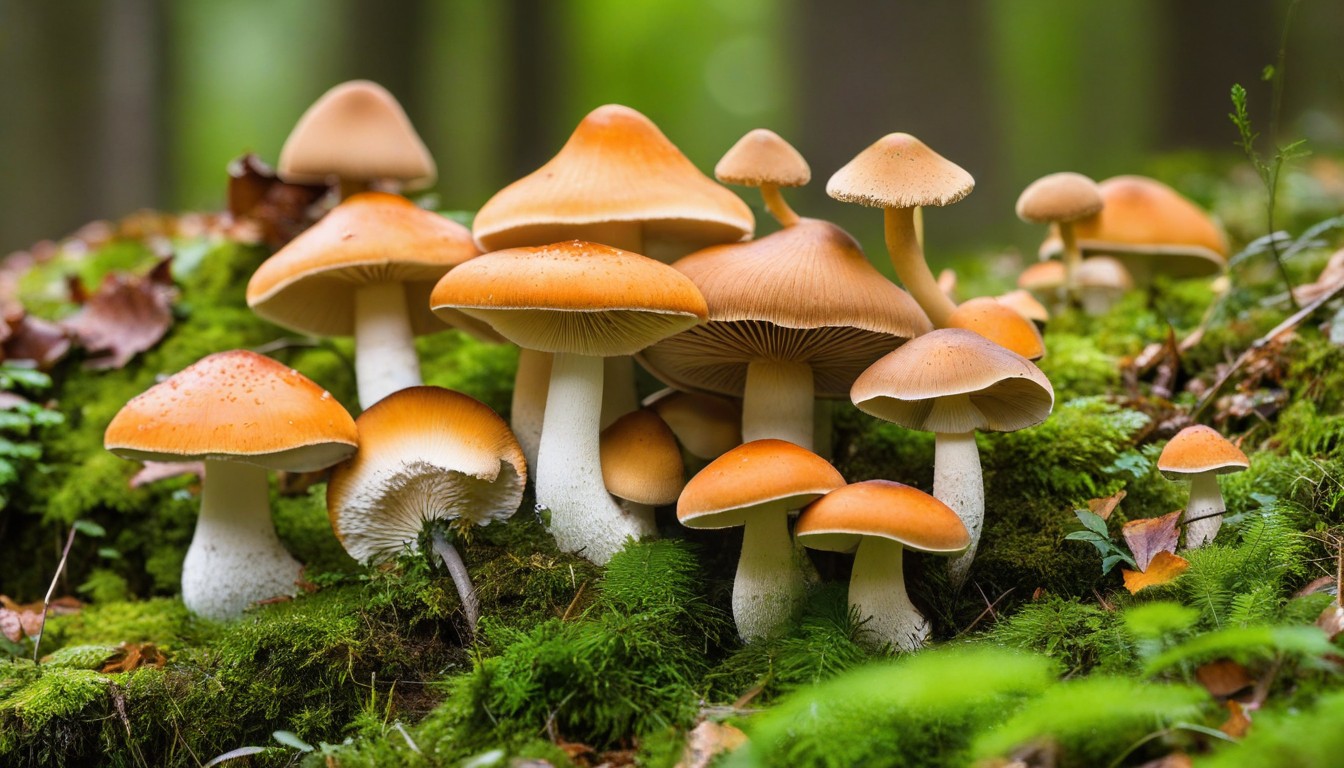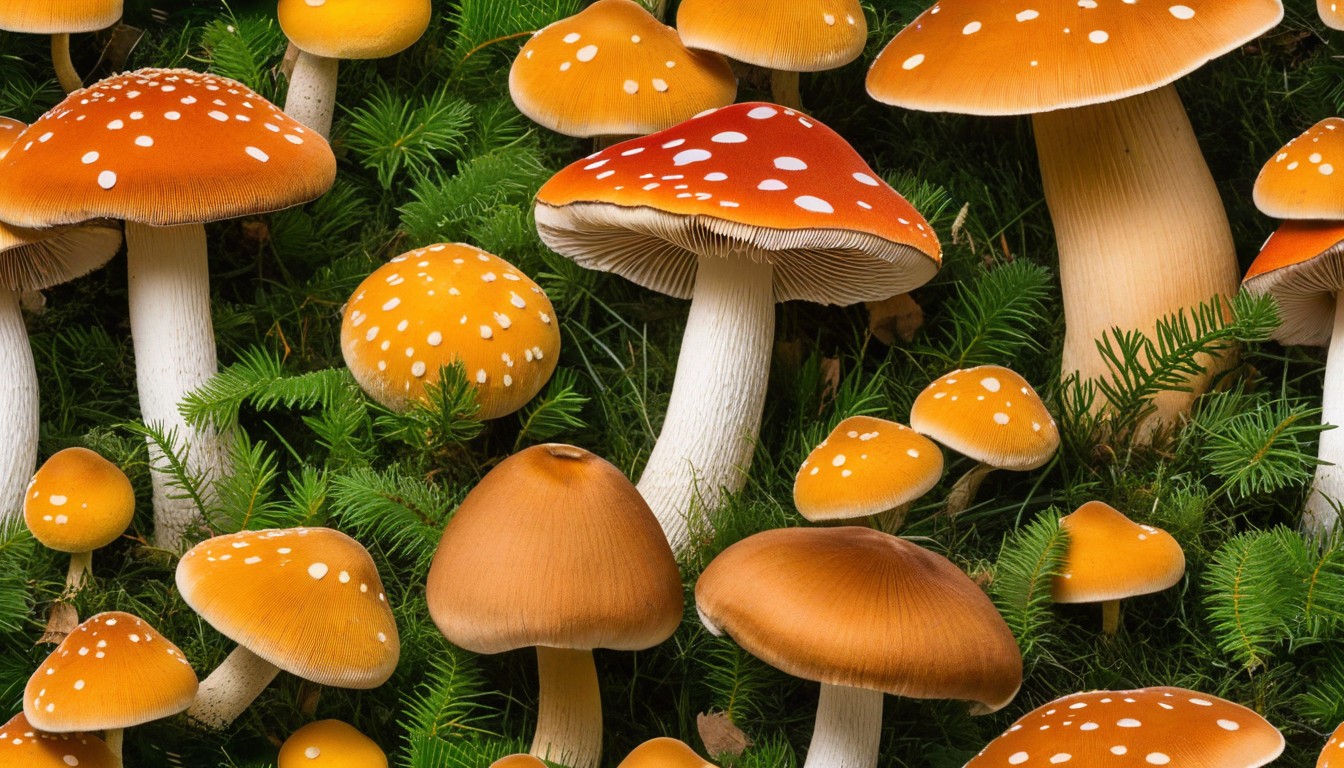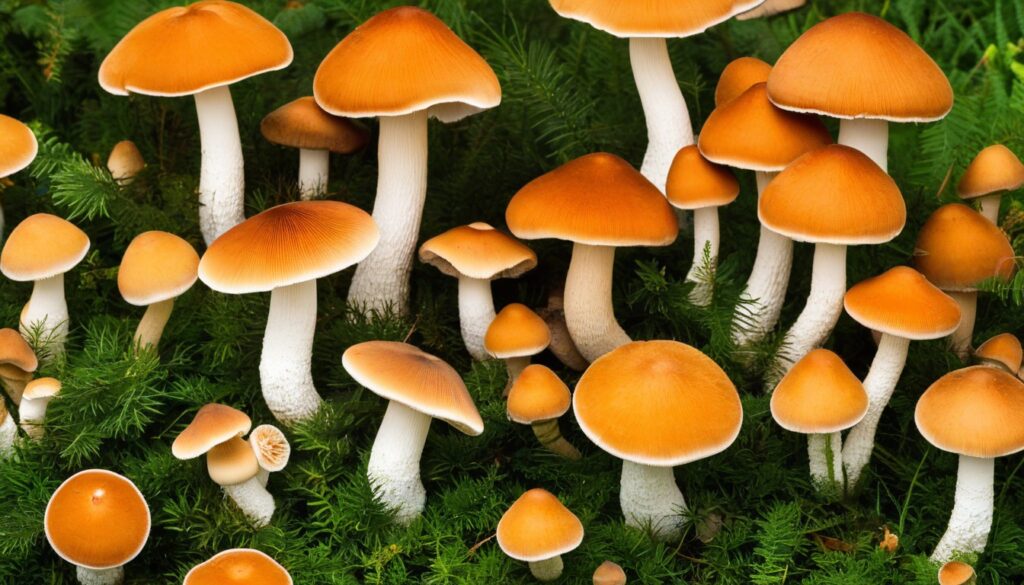Welcome to our comprehensive forager’s guide to edible fall mushrooms in Indiana. As the autumn leaves start to turn and temperatures drop, the Hoosier state comes alive with a wide range of delicious and nutritious mushrooms waiting to be discovered.
Foraging for mushrooms is a fun and exciting way to connect with nature and enjoy the outdoors while also exploring new culinary experiences. With our guide, you will learn everything you need to know about the most common and sought-after edible fall mushroom species in Indiana, where to find them, what safety precautions to take, and how to cook and preserve them.
Key Takeaways:
- Foraging for fall mushrooms in Indiana is worth the effort due to the variety of species and unique flavors.
- The guide focuses on common and sought-after edible fall mushroom species found in Indiana.
- The best locations in Indiana for mushroom foraging in the fall include state parks, forests, and other natural areas known for their abundant mushroom populations.
- Safety precautions such as proper identification, avoiding toxic species, and responsible harvesting practices are essential for mushroom foraging.
- Tools and equipment, cooking techniques and preserving methods, ethical foraging practices, and tips and tricks are discussed in detail in the following sections.
Why Forage for Fall Mushrooms in Indiana?
If you’re looking for a unique way to connect with nature, foraging for fall mushrooms in Indiana is a must-try activity. Not only is it an exciting way to get outdoors and explore the state’s natural beauty, but it’s also a great way to discover a variety of delicious and nutritious edible mushroom species.
Foraging for fall mushrooms in Indiana allows you to sample a wide range of flavors and textures, from the earthy taste of morel mushrooms to the rich meaty flavor of hen of the woods and the delicate, nutty notes of chanterelles. Additionally, mushroom foraging offers a thrill of discovery – the joy of finding a hidden patch of mushrooms tucked away in the forest is second to none.
Not to mention, foraging for fall mushrooms in Indiana can also be a great way to get some exercise and fresh air while enjoying the company of friends and family. So grab a basket, put on your hiking boots, and head out into the woods to explore the flavorful world of fall mushrooms!
Top Edible Fall Mushroom Species in Indiana
Indiana is home to a diverse range of edible fall mushroom species, each with its unique flavor and texture. Here are some of the most popular and sought-after mushrooms to look out for:
|
Mushroom Species |
Description |
Identification Features |
|---|---|---|
|
Chanterelles |
Golden-orange cap with wavy edges, yellow gills, and a fruity aroma |
Look for them near the base of hardwood trees in late summer and fall; avoid false chanterelles, which have gills that branch apart from each other |
|
Hen of the Woods |
A gray-brown cluster of ruffled leaves with a nutty flavor and tender texture |
Can be found at the base of oak trees in late summer and fall; look for the maitake, a similar-looking mushroom that grows on the same trees but is not as flavorful or tender |
|
Golden Oyster Mushrooms |
Golden-yellow caps with frilly edges and a slightly sweet, delicate flavor. |
Can be found growing on dead or dying trees in the late summer and fall. Look for clumps with overlapping caps and a soft, velvety texture. |
|
Puffballs |
Globe-shaped with a white, spongy interior and nutty flavor |
Pick them when they have reached their mature size, about the size of a grapefruit. Avoid puffballs that have begun to decay or turn yellow. |
|
Shaggy Mane Mushrooms |
Tall, thin mushrooms with shaggy white caps and a delicate, nutty flavor |
Identifiable by their white caps that begin to turn black and gooey at the edges as they age. They grow in clusters in fields and along roads in late summer and fall. |
Remember, when foraging for mushrooms in Indiana, it’s essential to have a reliable field guide and to take care when identifying the species you find. Only harvest mushrooms that you can confidently identify, and always leave some behind to spread spores and ensure the ongoing growth of these fascinating fungi.
The Best Foraging Spots in Indiana

Indiana boasts of several fantastic natural areas where local mushroom enthusiasts flock each fall to hunt for an abundance of edible fall mushrooms. Here are some of the top foraging spots in Indiana:
|
Park Name |
Location |
Notable Mushroom Species |
|---|---|---|
|
Brown County State Park |
Nashville, Indiana |
Chicken of the Woods, Chanterelles, and Hen of the Woods |
|
Morgan-Monroe State Forest |
Martinsville, Indiana |
Morels, Chanterelles, and Hen of the Woods |
|
Hoosier National Forest |
Bedford, Indiana |
Morels, Chanterelles, Hen of the Woods, and Porcini |
|
Hardy Lake State Recreation Area |
Scott County, Indiana |
Black Trumpet, Morels, and Chanterelles |
These are not the only foraging spots in Indiana, but they are some of the best. Remember to always obtain permission before harvesting mushrooms on private land and respect the environment while foraging for these delectable treats.
Safety Precautions for Mushroom Foraging

Mushroom foraging can be a fun and rewarding activity, but it’s important to take safety precautions to avoid any potential risks while out in the field. Keep the following tips in mind:
- Proper identification: Before consuming any wild mushroom, it’s crucial to properly identify the species. Many poisonous mushrooms resemble edible ones, so be sure to use a reliable field guide or seek advice from an experienced forager.
- Avoid toxic species: Some mushroom species can cause serious illness or even death, so it’s essential to know which ones to avoid. The Amanita genus is particularly dangerous, including the infamous Death Cap and destroying angel mushrooms. When in doubt, don’t eat it!
- Responsible harvesting practices: While it may be tempting to pick every mushroom in sight, it’s important to only take what you need and leave some behind for future growth and foraging opportunities. Be mindful of the environment and don’t damage surrounding vegetation or wildlife habitats.
By following these safety precautions, you can have a safe and enjoyable mushroom foraging experience in Indiana’s beautiful fall landscape.
Tools and Equipment for Mushroom Foraging
For a successful mushroom foraging experience in Indiana, make sure you have the right tools and equipment on hand. Here are some essentials:
|
Tool/Equipment |
Purpose |
|---|---|
|
Mushroom knife |
Used to cleanly cut the stem of the mushroom and avoid damaging the cap. Look for a curved blade and brush for removing debris. |
|
Basket or mesh bag |
Used to collect the mushrooms as you find them. Avoid plastic bags, which can trap moisture and cause mushrooms to spoil. |
|
Field guide |
Used to help you identify different mushroom species in the wild. Look for guidebooks specific to your region. |
|
Appropriate clothing |
Dress in layers and wear comfortable, waterproof shoes or boots. Bring rain gear as well in case of wet weather. |
With these tools and equipment in hand, you’ll be well-equipped to hunt for and identify the various edible fall mushroom species that Indiana has to offer.
Cooking and Preserving Fall Mushrooms

After harvesting a bountiful supply of fall mushrooms in Indiana, it’s time to think about cooking and preserving them for future culinary delights. There are several techniques to ensure the delicate flavors and textures of the mushrooms are retained.
Cooking Techniques:
Sautéed Mushrooms: Simply sauté the mushrooms in butter or olive oil with garlic and herbs for a quick and easy dish. Toss them into omelets, pasta dishes, or simply enjoyed as a side dish.
Mushroom Soup: Create a warm and comforting soup by blending sautéed mushrooms, vegetable or chicken stock, cream, and herbs. Add a crusty slice of bread on the side for a perfect fall meal.
Preserving Techniques:
Dehydrating: Dehydrating your mushrooms is a popular method to preserve them for future use. Set your dehydrator to 130-140°F and spread your sliced mushrooms on the racks. Once completely dried, store them in airtight containers for up to six months.
Canning: Canning is another useful method to preserve mushrooms, but always follow the necessary safety guidelines to avoid the risk of botulism. Pressure canning is the preferred method for mushrooms.
Freezing: Freezing mushrooms requires minimal effort, and they will keep in the freezer for up to three months. Simply blanch the mushrooms in boiling water for two minutes, cool them thoroughly, and then pack them in airtight containers or freezer bags.
|
Mushroom Recipe |
Description |
|---|---|
|
Mushroom Risotto |
A creamy and flavorful dish that highlights the earthy flavors of mushrooms |
|
Mushroom Tart |
A delicious and impressive appetizer made with sautéed mushrooms, creamy cheese, and buttery pastry |
|
Mushroom Stroganoff |
A comforting and hearty dish that pairs well with egg noodles or rice |
Try out these recipes and experiment with your own cooking techniques for a taste of Indiana’s fall mushrooms. Remember to always properly identify mushrooms before consuming them and to be safe while foraging.
Ethical Foraging Practices

When it comes to edible fall mushroom foraging in Indiana, it’s crucial to practice ethical and sustainable harvesting techniques. Not only does it ensure the longevity of our natural environment and its valuable resources, but also it’s respectful to the plant and wildlife inhabitants of these habitats too. Therefore, it’s crucial to employ the following ethical foraging practices:
|
Do |
Don’t |
|---|---|
|
Obtain legal access or permits to forage in the area. |
Forage in restricted areas or private property without permission. |
|
Respect the environment and its inhabitants. |
Leave trash or produce litter in the vicinity. |
|
Harvest only the mushrooms you can positively identify as edible. |
Take chances on questionable edible species. |
|
Use sustainable harvesting techniques that do not damage the environment. |
Damage the natural setting to gather your harvest. |
|
Take only what you can consume or preserve for later use. |
Overharvest or waste excess produce. |
|
Leave no trace behind when leaving the foraging site. |
Remove plants or any other materials from the ecosystem. |
By abiding by these ethical mushroom foraging practices, we not only maintain our ecosystem’s integrity but also respect the rights of other foragers and the natural resource available. This ensures that there are edible fall mushroom species for future generations and that they continue to flourish in Indiana’s rich and diverse woodlands.
Let’s all take a responsible approach to harvesting fall mushrooms and enjoy these incredible delicacies while safeguarding Indiana’s natural balance.
Mushroom Foraging Tips and Tricks
Foraging for edible fall mushrooms in Indiana can be a rewarding experience, but it’s important to have some tricks up your sleeve to make the most of your time in the field. Here are some tips to help you succeed:
Timing is everything
Most edible fall mushrooms in Indiana emerge in late September and October after significant rainfalls. Always check the weather forecast and plan your foraging trip accordingly. Frequent the same spots as first harvested that produced bountiful mushrooms.
Identify the ideal habitat
Understanding the specific growing conditions needed for different species of mushrooms is key. Look for shaded areas with moist soil, like near water sources, under trees, and on forest floors.
Use a mushroom knife
A mushroom knife with a curved blade makes it easier to cut mushrooms without damaging the delicate underground parts of the mushroom that will allow the main body to be regrown the following year.
Bring a basket or mesh bag
Use a basket or mesh bag to collect mushrooms instead of plastic bags. This allows mushroom spores to shake out and scatter, potentially growing new mushrooms in the future harvest.
Be vigilant and observant
While mushroom hunting, tread lightly, be aware of your surroundings, and observe the plants and animals around you. Keep an eye out for animal activity like digging or tree trunk regions or animals nibbling on mushrooms—it’s a sure sign that the area is likely a hot spot for mushrooms.
With these tips and tricks in mind, you’ll be on your way to harvesting delicious fall mushrooms in Indiana. Remember to always stay safe and respect the environment.
Conclusion
As you can see, fall mushroom foraging in Indiana can be both a thrilling adventure and a delicious culinary experience. With the help of this guide, you can confidently identify the most sought-after edible species, locate the best foraging spots, and practice ethical and sustainable harvesting.
Remember to always prioritize safety and respect for the environment, and to not harvest more than you need. With the right tools, techniques, and precautions, you can enjoy the flavors of fall and the wonders of nature through your foraging expeditions in Indiana.
So what are you waiting for? Grab your mushroom knife, basket, and field guide, and embark on your own foraging journey this season. Who knows what hidden treasures you may discover!
FAQ
What are edible fall mushrooms?
Edible fall mushrooms refer to the species of mushrooms that are safe and suitable for consumption during the fall season. These mushrooms can be found in various regions, including Indiana.
How do I know which fall mushrooms are edible in Indiana?
Proper identification is crucial when foraging for fall mushrooms in Indiana. It is recommended to consult reliable field guides, join foraging groups, or seek guidance from experienced mushroom foragers to learn about the edible species and avoid any potentially toxic mushrooms.
Where can I find edible fall mushrooms in Indiana?
Edible fall mushrooms can be found in various habitats, including forests, woodlands, and grasslands. Some popular foraging spots in Indiana include state parks, national forests, and nature reserves. It is important to respect the landowner’s guidelines and obtain any necessary permits before foraging.
Are there any poisonous mushrooms in Indiana?
Yes, there are poisonous mushrooms in Indiana, and it is essential to be cautious and knowledgeable about their identification. Avoid consuming any mushroom unless you are certain of its edibility. When in doubt, consult an expert or leave it be.
What safety precautions should I take while mushroom foraging in Indiana?
When mushroom foraging in Indiana, it is important to wear appropriate clothing and footwear for outdoor exploration. Always carry a reliable identification guide, use a mushroom knife or brush to collect specimens, and avoid consuming mushrooms without thorough knowledge. Additionally, be mindful of your surroundings, watch out for wildlife, and practice Leave No Trace principles.
What equipment do I need for mushroom foraging in Indiana?
Essential equipment for mushroom foraging in Indiana includes a mushroom knife, a basket or bag for collecting mushrooms, a field guide for identification, and suitable clothing and footwear. It is also helpful to bring a camera for documenting your finds.
How should I cook and preserve fall mushrooms?
Fall mushrooms can be cooked in various ways, including sautéing, baking, or adding them to soups and stews. To preserve fall mushrooms, they can be dehydrated, canned, or frozen for later use. There are numerous recipes and preservation methods available for exploring the flavors and textures of these seasonal delights.
What are ethical foraging practices?
Ethical foraging practices involve respecting the environment and its ecosystems while foraging for mushrooms. This includes not overharvesting, taking only what is needed, avoiding damage to the habitat, and leaving no trace. It is important to be mindful of the impact our actions can have on mushroom populations and their natural surroundings.
What are some tips and tricks for successful mushroom foraging in Indiana?
Some tips for successful mushroom foraging in Indiana include going out after rain, as mushrooms thrive in damp conditions, being observant and patient during your search, focusing on specific habitats where mushrooms are likely to grow, and continuously learning about mushroom identification and their preferred seasons.
How can I learn more about fall mushroom foraging in Indiana?
There are various resources available to learn more about fall mushroom foraging in Indiana. Consider joining local mushroom foraging groups, attending workshops or foraging classes, reading books written by experienced foragers, or exploring online forums dedicated to mushroom enthusiasts.

